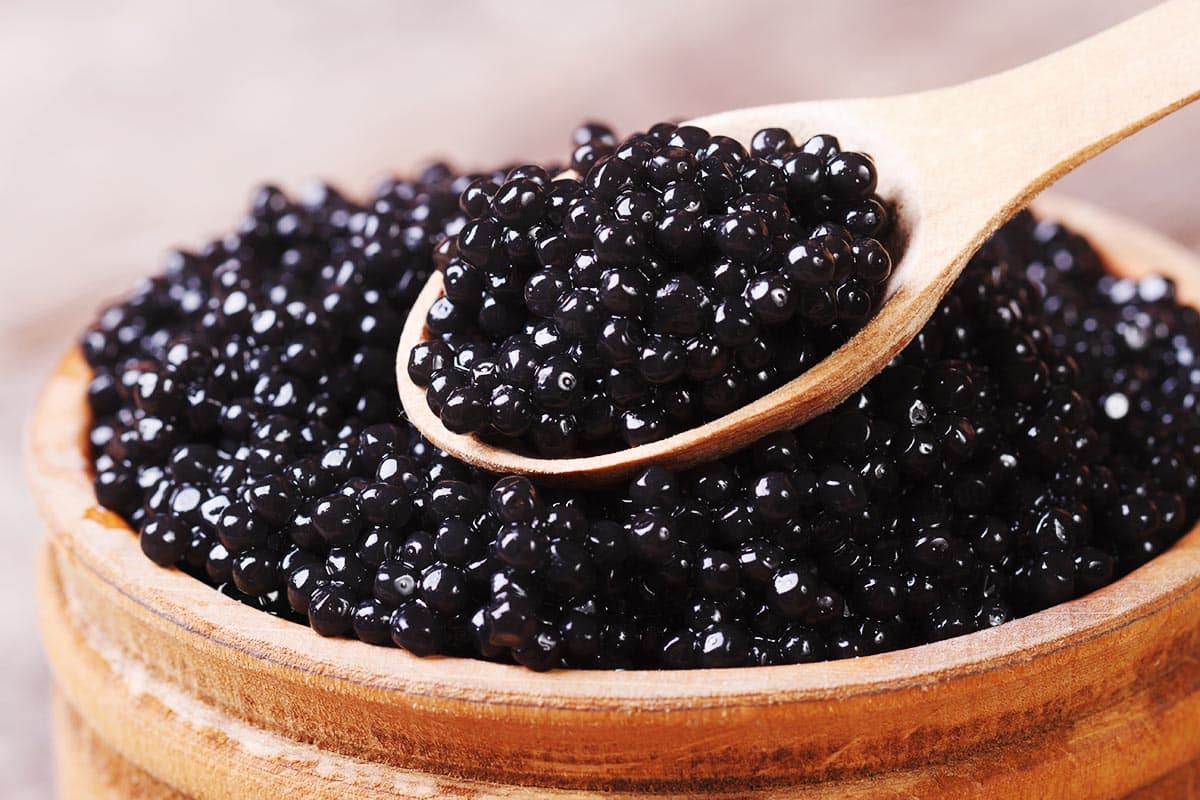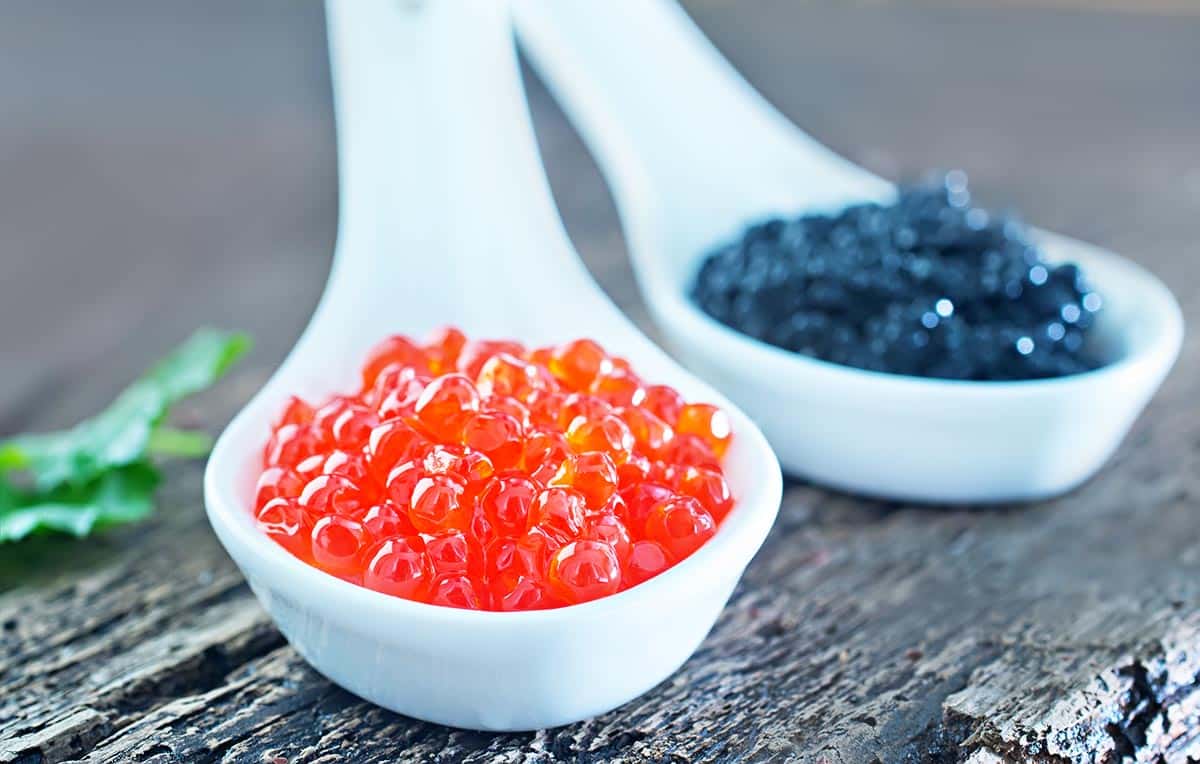People say that caviar is an acquired taste. But what does caviar taste like? You’ve come to the right place if you’ve never eaten fish eggs.
We’ll take you on a beginner guide on everything about caviar. Explore its flavors and the best way to serve caviar at dinner parties.

Caviar is a delicacy made from the salt-cured roe.
In plain terms, “roe” is another word for “fish eggs.” Caviar comes in varying forms, with pearl-like shapes and colors ranging from black to red.
This fish roe tastes best as garnish or spread. You can enjoy fresh caviar paired with plain crackers or canape toast.
Caviar is also one of the most expensive ingredients in the world, similar to truffles and saffron spice.
It’s not something that you’d easily find in grocery stores. If you’re curious about how caviar tastes and looking to try it, we recommend first checking into gourmet markets.
You can also buy fresh caviar online from trusted delivery services.
Although all-female fish produce eggs, not all fish roe is caviar.
High-quality caviar comes from sturgeon roe. Wild sturgeon is a fish commonly found in the Black and Caspian Seas.
Like salmon, sturgeon migrate from saltwater to freshwater to lay their eggs.
Making sturgeon caviar is a long and elaborate process. The fish is either captured in the wild or bred in specialty farms.
It also needs three to four years before it matures and lays eggs. Growers extract the fish eggs at a specific time.
They often use ultrasound machines for this method. After extraction, the sturgeon roe will undergo intensive filters to remove imperfections.
After that, salt is added to preserve the fish eggs before the canning process. Caviar will need aging for at least three more months before releasing it into the market.
Due to its laborious farming process, it’s no wonder caviar fetches a high price.
Luckily, there are other caviar varieties that you can try. These include fish roe from salmon, trout, or carp.
Salmon caviar is especially popular due to its red-colored eggs. Plus, it has a more affordable price.
Sturgeon alone has over 27 different species. Each one will have differing flavors.
Caviar tastes unique and depends on several factors. The fish’s overall health, age, and environment also affect its taste. But generally speaking, what does caviar taste like?
The taste of caviar is rich, briny, with a slightly buttery flavor.
Sturgeon roe is incredibly juicy and bursts in your mouth as soon as you eat it.
If you want to get an in-depth understanding of caviar’s flavor, pay attention to its texture.
The texture is an excellent indicator of quality.
High-quality caviar has a glossy texture and mild briny aroma, ensuring a fresh taste.
On the other hand, cheap caviar has a sticky, jelly-like consistency. The scent will be more intense, and the eggs will have a strong fishy taste.
Caviar tastes different depending on the fish variety. Most caviar comes from sturgeon roe, but other varieties are available too.
Here are five common types of caviar and their flavors:
Beluga caviar is derived from the Beluga sturgeon. It’s an endangered species native to the Caspian Sea. It is often considered the most prized and luxurious type of caviar. It is known for its large, glossy, and delicate eggs.
These eggs are pea-sized with a uniform black color. They have a delicate salty flavor with a smoothness like butter.
Due to its endangered status, this caviar is scarce and expensive. A pound of Beluga caviar can reach up to thousands of dollars. It’s also the highest grade of caviar available worldwide.
Osetra caviar originates from another sturgeon variety of the same name. Since Beluga caviar is extremely rare, this caviar is the next best thing.
Unlike Beluga caviar, Osetra roe is smaller, with colors ranging from black to brown.
Osetra caviar is best known for its salty yet nutty and creamy flavors. It’s also a popular caviar choice in European cuisines.
Kaluga caviar is the biggest of the caviar varieties. Unsurprisingly, the Kaluga sturgeon is also the biggest among its relatives.
The eggs are firm with uniform shapes and glossy gray color. But Kaluga caviar can also come in brown or olive green colors.
This caviar has a subtle briny aroma with a slightly salty taste. It also has a buttery flavor with earthy undertones.
Sterlet caviar is another rare type of caviar aside from Beluga.
It comes from the Sterlet fish, and its eggs are tiny compared to other varieties. Sterlet caviar is best known for its gray or yellow-colored eggs.
It has a delicate flavor with a rich buttery flavor and a smooth finish. Sterlet caviar is one of the most highly-coveted eggs aside from Beluga caviar.
Sevruga caviar has small eggs similar to Sterlet caviar. But unlike its counterparts, this caviar has the most intense flavor.
The egg’s small size allows it to absorb the brine faster. Sevruga caviar has the saltiest flavor.
It also has the most defined butter flavor among the different types. Luckily, this salty flavor offsets the eggs’ fishy taste or smell.
When buying caviar, you’ll notice that it comes in various colors.
The caviar’s color is usually an indicator of the fish variety.
Other times, it gives the buyer a clue as to the flavor and processing of the eggs.
Here are six standard caviar colors and their meanings:
Black caviar is the most common color you’ll see in the market. If you see black caviar, it likely came from a sturgeon fish.
Many sturgeon varieties like Beluga, Osetra, and Kaluga all produce black roe. Although the term is “black,” these eggs can have shades like gray or brown.
The blackest caviar comes from the Hackleback fish and is very popular in the United States.
Red caviar often refers to fish eggs in red, orange, or yellow shades. This type of caviar comes from fishes like trout or whitefish.
Since it doesn’t come from the sturgeon species, red caviar is not “true caviar.” But when it comes to flavor, red caviar tastes just as delicious as its pure varieties.
It’s also a popular choice due to its vibrant color and affordable price.
Gold caviar is only produced by a small number of sturgeon fish, especially in the Beluga species.
These eggs are pearl-shaped with a light shade of yellow, almost like antique gold. Since they are very rare, gold caviar is extremely expensive.
This caviar is best known for its succulent taste with hints of nutty and fruit flavors.
Yellow caviar is less rare than gold caviar but is still difficult to find. These eggs are usually associated with the Sterlet species.
The Sterlet fish usually produces gray eggs, but if the fish is an albino, it produces bright yellow roe.
Yellow caviar has a milky texture with a mild salty and fishy taste. It’s also surprisingly buttery and tastes delicious on crackers.
Green caviar is commonly seen in Japanese cuisine, especially sushi dishes. Farmers harvest these eggs from flying fish.
This species is abundant in the waters. The bright green hue isn’t natural and needs dyeing to achieve its look.
Green caviar is a staple sushi garnish with a distinct wasabi-like flavor.
White caviar is another name for “snail eggs.” They are tiny, creamy beads with nutty and earthy flavors.
There’s also a form of white caviar harvested from Iranian Beluga sturgeon. This type of caviar resembles small pearls and has a luxurious taste.
White caviar is rarer and more expensive than gold caviar.

The best way to eat caviar is to serve it fresh. Spread the eggs on ice and serve with a caviar spoon. Remember only to use bone spoons or pearl spoon to eat caviar. Never use silver or steel spoons on caviar because they can leave a metallic flavor.
Also Read
How To Eat Caviar Like A Pro.
To taste caviar, try eating it on its own first. Let the roe linger on the tongue, and try to feel its texture and juices.
You can also eat caviar with other foods like crackers, crostini, or crepes. But for maximum flavor, we recommend eating the delicacy fresh to preserve its taste.

Caviar is expensive because its farming process is long and laborious. The eggs are also difficult to harvest and come from limited stocks.
Snail caviar and Hackleback caviar are both cheaper substitutes for Sturgeon caviar.
Caviar is highly perishable and lasts only four to six weeks if stored properly. We recommend keeping caviar refrigerated and consuming it immediately after purchasing it and opening the jar.
The taste of Beluga caviar can be described as exceptionally rich, buttery, and smooth.
Caviar is a delicacy consisting of fish eggs from the sturgeon species. The eggs are pea-shaped, varying colors like black, red, or gold. There are five common types of caviar, with Beluga caviar being the most expensive. Each caviar type has its flavor profile. So, what does caviar taste like?
In general, caviar has salty and buttery flavors. It has a briny aroma with only a mild fishy scent. Caviar is best eaten alone or paired with crackers, crepes, or appetizers. It spoils quickly, so you should refrigerate it after opening it.





